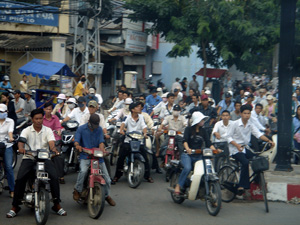Semester at
Sea Fall
2006 Voyage 
TABLE
OF CONTENTS
Tunnels for Tourists
by Ryan Bahry
Against the backdrop of low-lying buildings in Ho Chi Minh City, massive surges of traffic in the streets make it nearly impossible to traverse the downtown at dinner hour. Hundreds of Vietnamese, operating the a sea of cyclos, swerve dangerously in and out of the traffic flow, narrowly avoiding each other and the brave pedestrians who venture out into the streets. At first glance, Ho Chi Minh City seems extremely sheltered from transnational influence—a city composed of small buildings and primitive forms of transportation. However, having experienced Vietnam in greater depth, particularly in the historic grounds of the Cu Chi Tunnels, has allowed me to witness the various contrasts between the transnational and vernacular.
In class, we had read Christina Schwenkel’s article “Recombinant History: Transnational Practices of Memory and Knowledge Production in Contemporary Vietnam.” In her article, she examines the transnational effect that tourism has had on the portrayal of historical sites such as the Cu Chi Tunnels. She describes how the tunnels have been transformed into a public space where tourists are able to come and witness the “authentic” Viet Cong experience. I was fortunate enough to visit the Cu Chi Tunnels during my time in Vietnam, and experienced much of what I read about in the article. Just as described in Schwenkel’s article, a tour guide led our group to the small, disguised opening in the ground, demonstrated how the tiny-framed Vietnamese could easily fit through the entrance, and then asked for tourist volunteers to attempt to breach the opening.
The rest of the trip followed precisely as outlined in the article, and I was actually rather disappointed by how insincere the experience felt. However, it was interesting to witness how the Vietnamese have transformed this battlefield into a truly transnational, tourist-focused space. There was very little emotion left behind these sights—we were able to walk around the grounds, see destroyed American tanks, craters in the earth left from bombings, and witness demonstrations of the types of traps that existed throughout the jungle with very little discomfort, considering we were walking on the grounds of one of the most tragic, controversial conflicts of all time. Instead, we were able to purchase snacks, fire guns on a firing range, and think little of the actual events that took place there.
I’m left wondering several questions after leaving the Cu Chi Tunnels in Vietnam. In Schwenkel’s article, she describes an alternate spot where the Cu Chi Tunnels are more of a commercialized Disneyworld-esque location. At this site, it is more common for the Vietnamese to tour the tunnels. I would be interested to learn more of the differences that exist between the two sites, since the more “authentic” version that I visited felt extremely commercialized, like an amusement park. It would be interesting to observe the site where Vietnamese tourists are drawn and how it contrasts with the more transnational space that exists for those of us from outside the country to come and enjoy our afternoon of pleasant makeovers on the sites of unfathomable horror.
